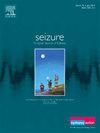抗癫痫药物对青少年肌阵挛性癫痫静息状态功能网络的影响:脑电图微态分析。
IF 2.7
3区 医学
Q2 CLINICAL NEUROLOGY
引用次数: 0
摘要
目的:青少年肌阵挛性癫痫(JME)与大范围脑网络功能障碍有关。本研究旨在通过静息状态脑电图微态分析,探讨抗癫痫药物(ASM)治疗如何改变JME患者静息状态功能网络。方法:96例受试者:健康对照24例(HC),未开始抗痉挛治疗(JME- nm)的新诊断JME患者29例(JME- nm),接受抗痉挛治疗并有效控制发作(JME- m)的JME患者43例(JME- m)。使用标准的19通道记录系统,在参与者清醒和闭眼休息时收集10分钟的脑电图数据。将脑电地形分为A、B、C、D四种微状态,计算并比较三种微状态间的平均持续时间、发生率、时间覆盖、转移概率等参数。采用先进的统计方法,以确保研究结果的稳健性和有效性。结果:与健康对照组和治疗组相比,未经治疗的JME患者(JME- nm)的脑电图微状态特征发生了显著变化。在JME-NM组中,微状态B的平均持续时间明显缩短,而微状态a的发生率增加,时间覆盖范围更广。特定微观状态(如从A到C、从A到D、从B到C)之间的转移概率在JME-NM组中也有显著差异。JME- m组这些参数的正常化表明,asm有效地稳定了改变的大脑网络,潜在地减轻了与JME相关的病理生理破坏。结论:本研究表明,asm有效地使JME患者的感觉-运动和视觉网络的中断正常化。脑电图微状态分析提供了大脑网络变化的动态视图,并为JME的诊断和监测以及评估治疗反应提供了潜在的生物标志物。这些发现促进了我们对JME神经生理机制的理解。本文章由计算机程序翻译,如有差异,请以英文原文为准。
Effects of anti-seizure medications on resting-state functional networks in juvenile myoclonic epilepsy: An EEG microstate analysis
Objective
Juvenile myoclonic epilepsy (JME) is associated with large-scale brain network dysfunction. This study aims to investigate how anti-seizure medication (ASM) treatment alters resting-state functional networks in JME patients through resting-state EEG microstate analysis.
Methods
Ninety-six subjects participated in this study: 24 healthy controls (HC), 29 newly diagnosed JME patients who had not started ASMs therapy (JME-NM), and 43 JME patients on ASMs treatment with effective seizure control (JME-M). EEG data were collected for 10 min while participants were awake and resting with their eyes closed, using a standard 19-channel recording system. EEG topographies were categorized into four microstate classes (A, B, C, D), and parameters such as mean duration, occurrence rate, time coverage, and transition probabilities between microstates were computed and compared among the three groups. Advanced statistical methods were employed to ensure the robustness and validity of the findings.
Results
Significant alterations in EEG microstate characteristics were observed in untreated JME patients (JME-NM) compared to both healthy controls and treated patients. Microstate B had a markedly reduced mean duration in the JME-NM group, while microstate A displayed an increased occurrence rate and greater time coverage. Transition probabilities between specific microstates, such as from A to C, A to D, and B to C, were also significantly different in the JME-NM group. The normalization of these parameters in the JME-M group suggests that ASMs effectively stabilize altered brain networks, potentially mitigating the pathophysiological disruptions associated with JME.
Conclusion
This study demonstrates that ASMs effectively normalize disruptions in sensory-motor and visual networks in JME patients. EEG microstate analysis provides a dynamic view of brain network alterations and offers potential as a biomarker for the diagnosis and monitoring of JME, as well as for evaluating treatment response. These findings advance our understanding of the neurophysiological mechanisms underlying JME.
求助全文
通过发布文献求助,成功后即可免费获取论文全文。
去求助
来源期刊

Seizure-European Journal of Epilepsy
医学-临床神经学
CiteScore
5.60
自引率
6.70%
发文量
231
审稿时长
34 days
期刊介绍:
Seizure - European Journal of Epilepsy is an international journal owned by Epilepsy Action (the largest member led epilepsy organisation in the UK). It provides a forum for papers on all topics related to epilepsy and seizure disorders.
 求助内容:
求助内容: 应助结果提醒方式:
应助结果提醒方式:


